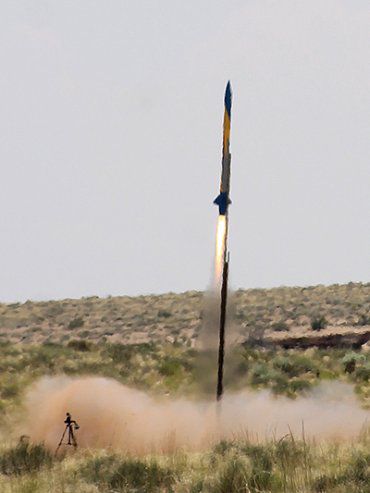Where in the world do you go if you want to launch rockets with plenty of room to spare. Green River is the spot with wide open spaces and enough free air space not to interfere with civilization. Colleges and universities from around the country and around the world brought their rockets to town for the event. The students prepare all year for the rocket competitive season that runs from March-June each year.
From June 24 through June 27 these competitors met for the 10th Intercollegiate Rocket Engineering Competition hosted by the Experimental Sounding Rocket Association of Logan. This competition is the largest university rocket competition in the world, with the highest-flying rockets and the largest scientific and technical payloads. More than 40 teams, their rockets, and payloads are evaluated by judges from the aerospace industry who also come from all over the country. This year, more than 55 rockets between 6 and 12 feet long were launched up to 23,000 feet high by teams from the US, Canada, Brazil, Egypt, India, and Turkey.
Maximum points are given for teams that design and build all of their rocket components, including the engine, airframe, electronics, and parachute recovery system. Bonus points are also given if precollege students design payloads for the rockets, as a way of encouraging them to pursue science, technology, engineering, and math in their studies. Awards were given in the Basic (10,000 feet) and Advanced (23,000 feet) categories, plus awards for Technical Excellence, Innovation, and Best Payload.
The rockets were displayed in the Green River High School gymnasium and student team members were available to answer questions. Due to safety concerns with these large, experimental rockets, the public was not allowed at the launch site. There was a rocket firing demonstration for the public and elementary-age children made their own paper rockets and launched them using compressed air.
Major sponsors are Orbital ATK-Chandler Ariz., Planetary Systems Corporation-Silver Spring, MD, Northrop Grumman Corporation-Falls Church, Virg., Space Exploration Systems-Hawthorne, Calif. and the Utah NASA Space Grant Consortium. The Utah State University Space Dynamics Laboratory hosted the Payload Challenge competition. Outreach activities were made possible by the City of Green River and Epicenter.
The emphasis of the ESRA rocket competitions is student design and construction of as many parts of the rockets as possible, including propulsion, structures, avionics, recovery, and payloads. The competition doesn’t prohibit commercial components or rockets, but more points are given for student-designed and -built hardware.
The two categories at the Competitions are Basic and Advanced. The Basic Category is to launch and recover a rocket with 10-lb payload closest to 10,000 feet above ground level (AGL). The Advanced Category may change from year to year but for the past few years it has been to launch and recover a rocket with 10-lb payload closest to 25,000 feet AGL. Currently teams may enter either or both categories without any “prerequisites.”
Massachusetts Institute of Technology won the basic class, and Mississippi State won the advanced class.
Part of the activities of Rocket Week this year at Green River was a museum night where Glenn Baxter of Green River gave a talk on his experiences launching Athena rockets from Green River in the 1960s and 1970s. This was during the era where White Sands Missile Base out of New Mexico had an installation in Green River.
There was also a panel discussion with Dr. Gil Moore (via internet) and Mr. Jim Barrowman after Glenn Baxter spoke.
Glenn Baxter graduated from Texas A&M with a BSEE (Electrical Engineering) in 1958, then reported to his first job with Convair Astronautics (San Diego, CA) later that summer. His work for Convair took him across the country working on various projects until he left Convair in Plattsburg, NY. He came to Green River to work for Atlantic Research on the Athena project in 1963 and worked there until 1976 when the Athena program was completed, then was self-employed.
One of the rockets at the launch malfunctioned, the booster “motor,” which is supposed to push the entire rocket skyward, instead fired right up through the booster like a cannon and shot the second stage upwards. The flaming cylinders seen falling from the sky were the solid fuel “grains” from the booster, that somehow shot up through the booster tube. The ill fated rocket is from the University of Waterloo, Canada.
The Universities and colleges attending this year included: Boise State, Brigham Young Idaho, California State University-Long Beach, Cairo University (Egypt), Case Western, Colorado State, Concordia (Canada) Eastern Washington, Embry-Riddle University-Daytona Beach, Embry-Riddle University-Prescott, EPUSP Sao Paulo (Brazil) ETS Montreal (Canada) Florida Tech, George Washington, ITA (Brazil) ITU (Turkey) ITU PARS (Turkey) Laval University (Canada) McGill (Canada) Mississippi State, Missouri University of Science and Technology, MIT, New Mexico Tech, Ohio State, Oregon State, Polytechnique Montreal (Canada) Queen’s (Canada), Rice, Ryerson University (Canada) South Dakota School of Mines, Texas A&M University, UCLA, UCSD, Univ of Akron University of Illinois – Chicago University of Michigan, University of Minnesota, University of Missouri, University of Nebraska-Lincoln, University of Toronto (Canada), University of Washington, University of Waterloo (Canada), UPES (India), Washington State University and West Virginia University.
Rocket launch competition in Green River

"One of the rockets lift off in the Intercollegiate Rocket Engineering Competition south of Green River."
